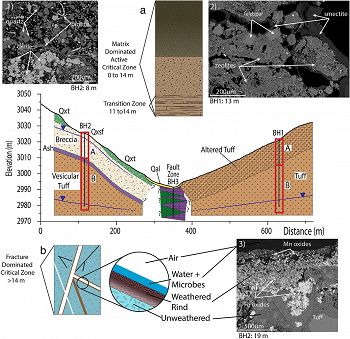Moravec et al., 2020
Resolving Deep Critical Zone Architecture in Complex Volcanic Terrain
Moravec B.G., White A.M., Root R.A, Sanchez A., Olshansky Y., Paras B.K., Carr B., McIntosh J., Pelletier J.D., Rasmussen C., Holbrook W.S., Chorover J. (2020)
Journal of Geophysical Research: Earth Surface 125(1): e2019JF005189 Cross-CZO
-
Catalina-Jemez, GRAD STUDENT
-
Catalina-Jemez, GRAD STUDENT
-
Catalina-Jemez, GRAD STUDENT
-
Catalina-Jemez, INVESTIGATOR
-
Catalina-Jemez, INVESTIGATOR
-
Catalina-Jemez, INVESTIGATOR
-
Boulder, Calhoun, Eel, Reynolds, Sierra, COLLABORATOR
-
Catalina-Jemez, INVESTIGATOR
Abstract
Conceptual model of CZ architecture in the ZOB. BH1 and BH2 reveal a matrix‐dominated, active CZ that extends approximately 14 to 18 m below the surface (A), as evidenced by measurable secondary mineral facies in bulk samples. (1) The active CZ in BH2 is comprised of rounded quartz and feldspar grains, frayed mica, and calcite precipitates in the matrix, indicating deposition of weathered materials (e.g., breccia). On‐going weathering processes are characterized by redox transformations and Si export coinciding with a shallow, perched aquifer. (2) The active CZ in BH1 consists of feldspar crystals coated with zeolites, likely precipitated shortly after eruption and prior to caldera resurgence. Pores coated with smectite are likely a result of contemporary CZ processes (including incongruent zeolite weathering to smectite). Below the zone of active matrix weathering, the CZ is fracture dominated (B). In this zone, weathering processes are not easily observed in bulk samples, but can be spatially resolved. (3) Fracture surfaces have pervasive Fe and Mn oxide coatings, which may reflect biologically mediated weathering at depth. BH3 represents the convergent zone whose connection to the subsurface architecture of the ZOB is not understood and may represent a combination of colluvial deposition and fault gouge. 1, 2, and 3 are backscatter electron microprobe images collected at the University of Arizona Earth and Planetary Sciences (Cameca SX‐100 electron microprobe, 15 kV accelerating voltage, 20 nA sample current, a beam size of 2 μm).
Critical zone (CZ) structure, including the spatial distribution of minerals, elements, and fluid‐filled pores, evolves on geologic time scales resulting from both top‐down climatic forcing and bottom‐up geologic controls. Climate and lithology may be imprinted in subsurface structure as depth‐dependent trends in geophysical, geochemical, mineralogical, and biological datasets. As the weathering profile is as much (or more) a product of past environmental conditions, development of predictive models requires understanding the relative roles of climatic forcing and the geologic template on which CZ processes evolve. Doing so in complex volcanic terrains with high initial bedrock porosity and distinct depositional and hydrothermal alteration histories is particularly challenging. To resolve CZ structure in a rhyolitic catchment in the Valles Caldera National Preserve (NM, USA), this study combined geophysics, drilling, and laboratory analyses to produce depth‐resolved porosity, geochemistry, and mineralogy datasets to >40 m in depth. Quantitative X‐ray diffraction analysis showed that local mineral transformations control complex chemical enrichment/depletion (τ) patterns. Using linear discriminant analysis, key variables enabled separation of complex‐layered geology into discrete zones. Contemporary, matrix‐dominated weathering processes and modern hydrologic fluxes occur dominantly within the top 15 m of the weathering profile. This zone is convoluted by incomplete primary mineral weathering and overprinted by post‐eruption weathering and metasomatism. Matrix weathering transitions to fracture surface weathering driven by deep percolation of slower moving, longer residence time meteoric waters at depth. By altering initial conditions and weathering trajectory, geologic legacy is a critical factor in how this subsurface landscape evolved and functions.
Citation
Moravec B.G., White A.M., Root R.A, Sanchez A., Olshansky Y., Paras B.K., Carr B., McIntosh J., Pelletier J.D., Rasmussen C., Holbrook W.S., Chorover J. (2020): Resolving Deep Critical Zone Architecture in Complex Volcanic Terrain. Journal of Geophysical Research: Earth Surface 125(1): e2019JF005189. DOI: 10.1029/2019JF005189
 This Paper/Book acknowledges NSF CZO grant support.
This Paper/Book acknowledges NSF CZO grant support.
Explore Further









